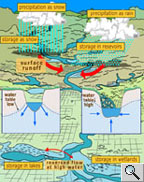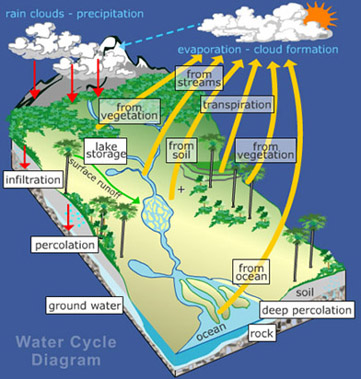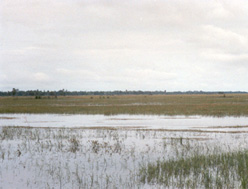4.2 THE HYDROLOGICAL CYCLE
Surface and groundwater / Evaporation and transpiration / The hydrological regime
The Origins of Water--
 Water
falls on the land in the form of rain, hail and snow. Rain and hail fall
at lower altitudes and snow is confined to higher, mountainous regions.
Water falling as rain and hail immediately starts to flow to the sea,
although the speed at which this occurs is influenced by many things.
Water falling as snow may be stored on the mountains for many years, but
a certain amount melts and starts to flow to the sea through the headwater
streams every hot season. Water also sinks into the earth where it is
stored and released into rivers from springs over the whole year. Most
tropical rivers are fed mainly by rainfall.
Water
falls on the land in the form of rain, hail and snow. Rain and hail fall
at lower altitudes and snow is confined to higher, mountainous regions.
Water falling as rain and hail immediately starts to flow to the sea,
although the speed at which this occurs is influenced by many things.
Water falling as snow may be stored on the mountains for many years, but
a certain amount melts and starts to flow to the sea through the headwater
streams every hot season. Water also sinks into the earth where it is
stored and released into rivers from springs over the whole year. Most
tropical rivers are fed mainly by rainfall.
Surface and Groundwater--
On land, water is present in three forms - as snow and ice in high mountains,
as surface water in rivers, lakes and marshes and underground as groundwater.
Surface Water
The water in rivers flows downhill to the sea or to a lake. In places
dams may interrupt this flow artificially, but the water continues to
flow through. Water in natural lakes is normally stored for much longer
periods, although even here water flows through where there is an out-flowing
river. The amount of time water stays in a reservoir or lake is known
as the residence time; the time it takes to change all the water in a
lake or reservoir is known as the replacement rate. Residence times and
replacement rates can range from years in large, natural lakes to weeks
in large reservoirs and days in run-of-the-river dams.
 |
Ground Water
Much of the water falling on the land filters through the surface soil
and rock to form ground water. The amount of wat re
stored as ground water is third to the sea and to glaciers and icecaps.
Most of this water lies up to 100 metres below the surface and is stored
in aquifers. These are areas where porous rocks are underlain by waterproof
rocks. They form a valuable resource that is reached by wells, and is
used widely for drinking water and for agriculture. In some areas the
porous layer comes to the surface and the stored water emerges as a spring.
Water closer to the surface forms the water table upon which plants depend.
Lakes, swamps and marshes occur where the water table is higher than the
surrounding land, although they may also occur at other places in the
rivers basin where channels are obstructed, or where there are impermeable
layers in the bedrock. Water is withdrawn from the ground water by evaporation,
filtration and human use; the water table lowers accordingly. Swamps and
marshes may dry out when this occurs. This water is replenished during
the floods.
re
stored as ground water is third to the sea and to glaciers and icecaps.
Most of this water lies up to 100 metres below the surface and is stored
in aquifers. These are areas where porous rocks are underlain by waterproof
rocks. They form a valuable resource that is reached by wells, and is
used widely for drinking water and for agriculture. In some areas the
porous layer comes to the surface and the stored water emerges as a spring.
Water closer to the surface forms the water table upon which plants depend.
Lakes, swamps and marshes occur where the water table is higher than the
surrounding land, although they may also occur at other places in the
rivers basin where channels are obstructed, or where there are impermeable
layers in the bedrock. Water is withdrawn from the ground water by evaporation,
filtration and human use; the water table lowers accordingly. Swamps and
marshes may dry out when this occurs. This water is replenished during
the floods.
Of the total amount of water in the world, the proportion stored in various areas is as follow:
- Oceans: 97%
- Icecaps and glaciers: 2%
- Ground and soil: 0.5%
- Stream, rivers and lakes: 0.02%
- Atmosphere: 0.0001%